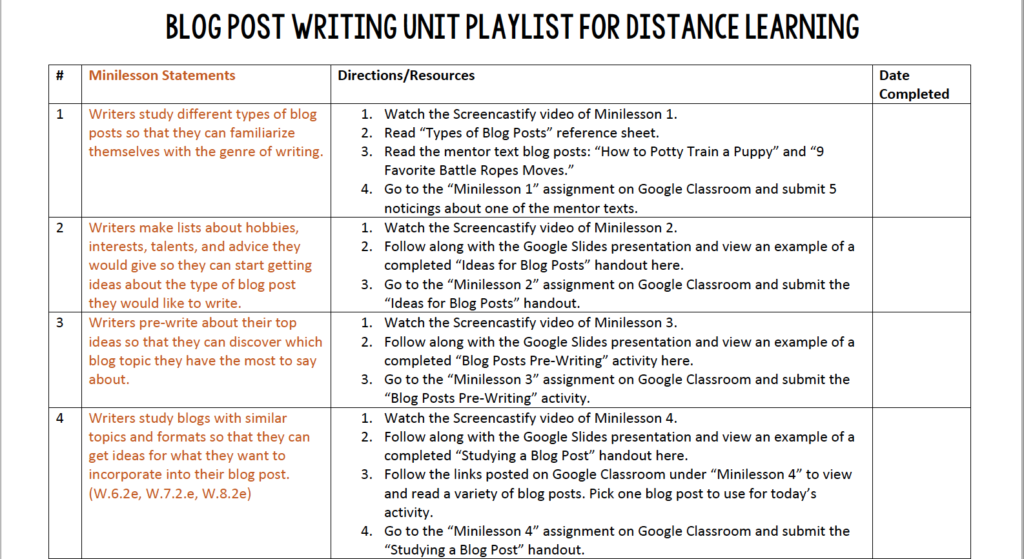For the last few school years I have shifted my writing instruction from a Writing Workshop approach to more what I would consider a writing units approach. Across the school year, we do four separate writing units. (I used to attempt to teach a reading minilesson and writing minilesson each day but have shifted to alternating between reading and writing units.) Each writing unit has an end goal in mind with a particular writing product all students end up with. All writing units share similar components: genre immersion, pre-writing, organizing & outlining, drafting, revising, editing, and publishing. I generally teach one minilesson each day, and each writing unit contains 13-15 minilessons total.
When schools were shut down due to Covid-19 and distance learning started, I began to consider how I could make a writing unit more user-friendly for students in a digital format. I’ve always wanted to try an interactive, digital playlist and now seemed like the perfect time to try. A writing unit is a perfect thing to make into a playlist because writing should be a more self-paced experience where students spend the time they need on the various steps of the writing process. Below I will outline the steps I took to make a writing unit into an interactive, digital writing playlist.
- Make a playlist outline. I started by taking my writing unit plan and then adding a few columns to it. The columns I added were: “Directions/Resources” and “Date Completed.”
- Make Screencastify Video Minilessons. Screencastify has been a game-changer for me. I often take minilessons and make them into Screencastify videos to post on Google Classroom, even when I am teaching a lesson live to use as a second exposure opportunity and/or for students to watch if they were absent. In this case, I put up my Google Slides presentation for a particular minilesson and talked through the minilesson to give the main teaching points and directions and talked through the examples. As much as I’d love my students to be better at reading written directions and being able to follow them, I have learned that many students do better hearing my voice while simultaneously seeing the minilesson presentation in a Screencastify video. I know that I would personally do better as a student with this format, too. For the writing unit, I took each minilesson of the 13 minilessons and made them into Screencastify videos. In the “directions” on my playlist document, I ask students to watch the Screencastify video for each minilesson. Distance learning and digital learning can quickly become very cold-feeling, and whenever I can have my students hear my voice, see my face, and verbally get to communicate with them, the depersonalization of distance and digital learning goes away (at least a little).
- Make all the resources students will need to access “linkable” by uploading them to Google Drive. In the “Directions & Resources” part of the playlist, link all of the necessary documents students will need to access. I know most of you know how to do this, but it simply means uploading all of the documents needed to Google Drive, turning the documents I need students to complete into Google Docs, and including the direct links to these documents right on the playlist.
- Decide the places you want students to stop and get feedback from you before moving on. Teaching writing using an interactive, digital playlist frees the teacher up for the most important thing a teacher can do throughout the writing process: give feedback. Now every student doesn’t need feedback on every minilesson. That’s why it’s important as you’re building the writing unit playlist to decide when you think it’s necessary for students to get feedback from you, when it is recommended, and when it’s not necessary. There is a fine balance in giving feedback, but also letting students explore and be independent writers. For me, I love reading over students initial draft and giving a lot of feedback in the middle of the writing process versus toward the end. I find students are much more open to revision ideas at this point rather than when they’ve already done revision minilessons and are feeling like their draft is almost complete.
- Monitor and guide students through the process. If students aren’t familiar with a playlist concept, especially middle school students, it will require modeling of organization and giving recommended checkpoints. Self-paced learning is amazing, but this is new to a lot of students, and we also need to teach them what this level of independence looks like to set them up for success.

If you’re looking for some inspiration for where to go next with your middle school ELA students when it comes to writing instruction, I hope this post gave you what you were looking for.
If you’re looking for writing units that are ready-to-go and fully editable, you can also check out the 10 different writing units I have available that are linked below. Any of these writing units could easily be personalized and turned into a digital, interactive writing unit playlist for your students.
Persuasive Writing Units:
–Product Review
–Book Recommendation
–Important Issue Letter
Informative/Explanatory Writing Units:
–Blog Post
–Literary Analysis
–Quote to Live By Essay
Narrative Writing Units:
–Memoir Vignettes
–Narrative Nonfiction
–Deleted Scene
Research Unit:
–Ask Anything
Let me know your thoughts on writing unit playlists. I’d love to hear from you!
-Kasey





